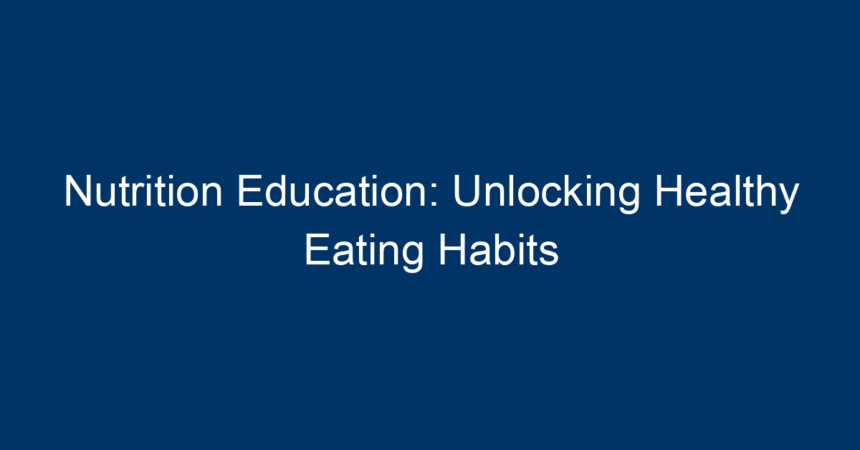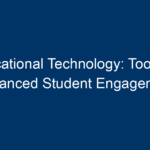In today’s fast-paced world, where convenience often triumphs over health, nutrition education has emerged as a vital tool in promoting healthy eating habits. Understanding what to eat, why it matters, and how to make informed choices can significantly influence our overall well-being. This comprehensive guide will explore nutrition education, its significance, and practical steps to incorporate it into daily life to foster healthy eating habits.
The Importance of Nutrition Education
Understanding Nutrition Education
Nutrition education involves teaching individuals and communities about the fundamentals of healthy eating. It covers dietary guidelines, the nutritional value of foods, and the role that nutrition plays in health and disease prevention. Equipped with this knowledge, people can make choices that enhance their quality of life.
Why Nutrition Matters
Good nutrition is essential for:
- Physical Health: A balanced diet supplies essential nutrients that our bodies need to function effectively. This supports everything from bone health to immune function.
- Mental Well-Being: Recent studies indicate a direct correlation between nutrition and mental health. A well-balanced diet may reduce the risk of depression, anxiety, and cognitive decline.
- Disease Prevention: Many chronic diseases—such as obesity, diabetes, and heart disease—can be prevented or managed with healthy eating habits.
The Role of Nutrition Education in Creating Change
Nutrition education empowers individuals to make healthier choices and fosters lifelong habits. Understanding the principles of nutrition also encourages healthier community norms and policies, bolstering public health at a broader scale.
Core Principles of Nutrition Education
1. Nutritional Literacy
Nutritional literacy is the foundation of effective nutrition education. This involves understanding nutritional labels, food groups, and serving sizes. Individuals equipped with this knowledge can decipher food packaging and make healthier decisions when shopping or dining out.
Key Components of Nutritional Literacy
- Reading Labels: Learning to identify ingredients and nutritional information such as calories, fats, sugars, and vitamins.
- Understanding Food Groups: Recognizing the five food groups and their recommended servings.
- Making Informed Choices: Knowing how to choose fresh, nutrient-dense foods over processed options.
2. Balanced Diet
A balanced diet includes a variety of foods rich in different nutrients. Emphasizing the importance of consuming fruits, vegetables, whole grains, lean proteins, and healthy fats helps anchor nutrition education.
Building a Balanced Plate
- Fruits and Vegetables: Aim for at least five servings a day, prioritizing a colorful variety.
- Whole Grains: Choose brown rice, oats, and whole-grain bread over refined options.
- Proteins: Include both plant-based (beans, nuts) and animal-based sources (lean meats, fish).
- Dairy or Alternatives: Incorporate low-fat dairy or fortified plant-based alternatives.
3. Portion Control
Understanding portion sizes is essential for maintaining a healthy weight. Overeating, even healthy foods, can lead to weight gain and associated health issues.
Tips for Portion Control
- Use Smaller Plates: This can help manage serving sizes.
- Mindful Eating: Pay attention to hunger cues and avoid distractions during meals.
- Pre-Portion Snacks: Prepare snack sizes in advance to avoid overeating.
Strategies for Effective Nutrition Education
1. Community Workshops and Seminars
Organizing workshops and informational seminars in schools, workplaces, and community centers can enhance the reach of nutrition education. Interactive sessions can provide practical cooking demonstrations, meal planning tips, and nutrition quizzes to engage participants.
2. Online Resources and Mobile Apps
In a digital age, numerous online resources and apps are dedicated to nutrition education. Websites, videos, and apps can offer easy access to meal planning tools, nutritional information, and tracking capabilities.
3. Integrating Nutrition into School Curricula
Integrating nutrition education into school programs can instill healthy habits from a young age. Schools can implement cooking classes, gardening programs, and nutrition courses that engage students in hands-on learning.
4. Social Media Campaigns
Utilizing social media to disseminate information about nutrition can vastly widen the audience. Campaigns that share quick tips, recipes, and success stories can motivate individuals to improve their eating habits.
The Benefits of Nutrition Education
Improved Health Outcomes
By understanding nutrition, individuals can reduce their risk of chronic diseases and improve their overall health. This can lead to a more robust public health landscape and reduce healthcare costs.
Enhanced Quality of Life
Nutrition education fosters not only physical well-being but also improved mental health. A nutritious diet contributes to greater energy levels and overall life satisfaction.
Economic Advantages
Investing in nutrition education can yield economic benefits by decreasing healthcare costs associated with diet-related diseases. Healthier individuals may also experience increased productivity in the workplace.
Challenges and Barriers to Nutrition Education
While the importance of nutrition education is evident, several barriers can hinder its effectiveness:
Limited Access to Resources
In some communities, access to healthy foods and nutrition education resources is limited. Food deserts can leave individuals relying on less nutritious processed foods.
Misinformation and Myths
The prevalence of misinformation about diets and nutrition can lead to confusion. Nutrition education must counteract these myths with evidence-based information.
Behavioral Resistance
Established habits and cultural preferences can impede the adoption of new dietary practices. Encouraging gradual change can help ease transitions to healthier choices.
Actionable Insights for a Healthier Lifestyle
1. Start with Small Changes
Begin making small, sustainable changes to your diet. Swap regular soda for sparkling water or choose a piece of fruit for dessert. These adjustments can lead to lasting habits.
2. Educate Yourself
Take initiative by exploring online courses, reading nutrition books, or following reputable nutrition blogs. Knowledge is power when it comes to making healthy choices.
3. Seek Professional Guidance
Consider consulting a registered dietitian or nutritionist. Personalized advice can help tailor dietary changes to your specific health needs and goals.
4. Involve Family and Friends
Engage your loved ones in nutrition education by cooking together or participating in community food events. Making health a shared journey can foster support and accountability.
5. Monitor Your Progress
Keep track of your dietary changes, whether through journaling or using mobile apps. Reflecting on your progress can motivate you to stay committed to your healthy eating journey.
Conclusion
Nutrition education holds the key to unlocking healthy eating habits that can significantly enhance the quality of life. By understanding nutritional basics, promoting balanced diets, and incorporating practical strategies, individuals and communities can cultivate a culture of health. The journey to better nutrition begins with education—an empowering tool that equips us to embrace informed choices and ultimately lead healthier, happier lives. Start today, and take the first step toward a nutritious future!




